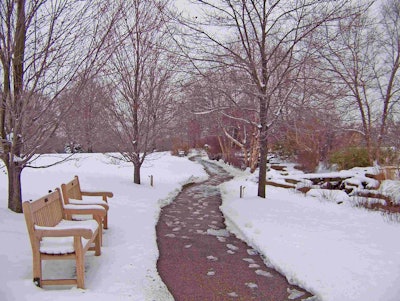
While rock salt remains a reliable and effective choice thanks to its ability to lower the freezing point of water, salt brine serves as a more environmentally friendly option that can stay put when applied beforehand.
Because adding liquids to your snow removal side of the business comes with costs, it’s better to phase in the new strategies. When first starting out, purchasing reputable brine or engineered liquids can guarantee consistency. Yet over time if a contractor is wanting to optimize their cost-effectiveness it may be time to learn how to make and store their own brine.
Challenges of creating brine
Despite what some DIY sites would lead you to believe, creating salt brine takes more than dumping some salt in a bucket of water. This method can produce salt brine but it is too slow and wasteful to be practical in a business operation.
Water flow
There are various brine makers, but it is important to know how much water you have or can obtain (gallons per minute) because it does no good to have a model that has a high output but you can’t feed that much water in.
Knowing what your current situation will help you decide what type of brine maker to purchase, and whether the cost of increasing the flow is worth it. You want a system that works for your situation so you need to be aware of your facility’s capabilities.
Facilities and pumps
Aside from knowing your water system’s limits, you also need to be conscious of how the delivery of the brine ingredients, storage and loading of the finished products will be handled. It defeats the purpose of setting up the system if the lack of logistics cancels out any efficiency you could have gained by making your own brine.
It’s important to consider where the pumps will be located and plumbed in at. Ensuring that they have the correct ratings for the intended use and have the right seals will help the system last its expected lifetime.
Brine maker clean out
Before you commit to a brine maker, you must be fully aware of what it will take to clean the system on a regular basis, otherwise productivity will drop. The quality is ensured when the brine maker is kept clean and insoluble materials are regularly removed.
Cleaning could be as simple as opening a valve and pushing a button while other models may require getting in a shoveling out the system or disconnecting portions and tipping the brine maker over.
Dangers of creating brine
Because salt brine tends to only be effective at the temperature range of 20 to 35 degrees Fahrenheit, chemicals such as calcium chloride or magnesium chloride can be added to lower the freezing temperature of water more. This also causes the solutions to have a strong affinity for water so be aware of some of the dangers that come with brine handling.
The personal protective equipment to be worn during brine handling varies during the specific task being performed but hard hats, goggles or safety glasses, rubber gloves and rubber boots are the minimum suggested safety apparel when working with brine fluids.
Contact while handling
If the fluid comes in contact with the skin, it can cause slight irritation and redness if exposed only for a short time. Prolonged or continued exposure can result in superficial to severe burns on the skin. Contact to the eyes can cause moderate to severe irritation or even corneal injury.
If the brine makes contact with the skin, flush the skin with water for at least 15 minutes and contact medical personnel as soon as possible. If eye contact occurs, irrigate the eyes for at least 15 minutes as well.
Toxic fumes
Brines are not flammable but they can release chlorine and/or bromine gases in the case of a fire from another source. Another way toxic fumes can form is when oxidizers such as calcium hypochlorite can release the gases under acidic conditions.
These gases are heavier than air and will settle into lower or confined spaces and displace all breathable air.









